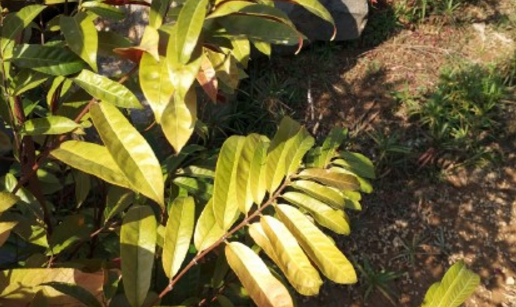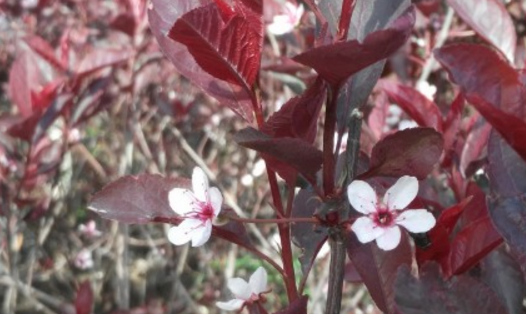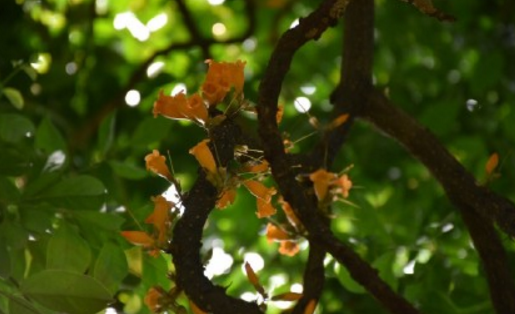Is sea lacquer red back cinnamon poisonous? Breeding methods and matters needing attention? The role of leaves?
Red back osmanthus is red back sweet-scented osmanthus, it is Euphorbiaceae evergreen shrub, because its leaf back is red, so red back osmanthus poisonous? Breeding methods and matters needing attention? The role of leaves? According to data, red back cassia is non-toxic, but it is a carcinogenic plant, so it is best not to keep it indoors for a long time. Experiments show that the "Epsteln-Barr virus early antigen inducer" contained in these carcinogenic plants can induce EB virus to transform into lymphocytes and promote tumor growth caused by tumor viruses or chemical carcinogens.

Is the red back cinnamon poisonous?
There is no poison, but it is a carcinogenic plant, so it is best not to keep it indoors for a long time. Experiments have shown that the "Epsteln-Barr virus early antigen inducer" contained in these carcinogenic plants can induce EB virus to transform into lymphocytes and promote tumor growth caused by tumor viruses or chemical carcinogens.
At present, experiments on nasopharyngeal carcinoma and esophageal cancer induced by carcinogenic plants have been confirmed that they are not only "poisonous" all over the body, but also activated substances containing carcinogenic viruses and chemical carcinogens have been detected in the soil where such plants have been planted.
If there are such plants in the house, people may cause cancer due to long-term inhalation of pollen, dust particles and other reasons.
II. Breeding methods and matters needing attention
Temperature
Red back cassia is a subtropical plant, which is not cold-tolerant. The suitable temperature for growth is between 15-25 ℃, and the overwintering temperature should be not less than 5 ℃.
Light
Resistant to semi-shade, like scattered light, avoid strong light exposure, summer needs to be placed in a shaded and ventilated place, which is conducive to keeping the red back cinnamon leaf color dark green.
Watering
Red back cinnamon likes moist growth environment, but avoid waterlogging. Fully watered during the growing period, keep the basin soil and the surrounding environment moist, but pay attention to avoid stagnant water. Control watering in winter, generally watering every 7-10 days, basin soil is slightly wet and dry.
Fertilizer application
When planting or turning the basin and changing the soil, some compound fertilizer can be applied as the base fertilizer, the compound fertilizer containing nitrogen, phosphorus and potassium can be applied once in the growing period, and 0.2% potassium dihydrogen phosphate solution can be sprayed twice during flowering. Fertilizers are not needed in midsummer and winter.
Soil
Like fertile, loose, well-drained sandy loam.
Reproduction method
Two propagation methods of root division and cuttage can be adopted. The root splitting method is generally carried out in March or April of each year, and 2-3-year-old seedlings are selected for planting. The most common is cuttage propagation, select annual strong branches as cuttings, cut into every three segments into plain soil, about 23 cm deep, shade and moisturizing about two months can take root.
Matters needing attention
Anthracnose, leaf blight and root-knot nematode disease are common in pest control. The first two diseases can be treated by spraying 65% zinc wettable powder 500 times, and 3% carbofuran granules can be applied to the prevention and control of diseases. Red-backed cassia is easy to be harmed by scale insects, so pay attention to prevention and control.
The cultivation soil must be mixed with acid soil, and the basin should be changed every two years according to the growth situation. It is appropriate to keep it under the shade in the hot season, and applying acid liquid fertilizer every 2-3 weeks can make the branches and leaves luxuriant and keep the leaves bright.
The room temperature in winter should not be lower than 12 ℃, otherwise a large number of leaves will fall and the plants will go into dormancy, and the twigs will wither at the same time. If this happens, re-pruning should be carried out immediately to promote new shoots. Pay attention to the wind when moving out in spring, otherwise it is easy to cause the leaf to curl or even the leaf edge to dry up.
Third, the function of leaves?
1. Ornamental value of red back cinnamon
Red-backed cinnamon, as the name implies, its leaves are bright red and bright, is a good foliage plant. Its leaf surface color is green, very shiny, the whole plant looks red and green, very beautiful. As a potted plant put indoors, it appears beautiful and dignified, has a good beautification effect on the environment, and gives people a pleasant feeling. Planted in the courtyard or park, because of its unique color will form a beautiful scenery, very eye-catching, giving people the enjoyment of beauty.
2. Medicinal value of Cortex Cinnamomi
The whole plant of Hongbeigui can be used as medicine, which has the functions of dispelling rheumatism, activating menstruation, activating blood circulation and relieving pain. it plays a certain role in the treatment of measles, tonsillar inflammation, angina pectoris, mumps, lumbar muscle strain, fall injury and so on. It can be fried into soup for internal use, or the right amount of fresh products can be mashed for external use.
Time: 2019-03-16 Click:
- Prev

When does the purple leaf dwarf cherry of Rosaceae bloom? How do you breed? What is the difference between purple leaf plum and purple leaf plum?
Purple leaf dwarf cherry has good ornamental effect, fast growth, simple reproduction, resistance to pruning and strong adaptability, so when will purple leaf dwarf cherry blossom? How do you breed? What is the difference between purple leaf plum and purple leaf plum? According to the data, the purple leaf dwarf cherry usually blossoms in spring, and its flowering period is in April and May.
- Next

The taboo of burning flowers in the family Viburnaceae for breeding in winter? How do you breed? What are the effects and effects?
Fire burning flowers can withstand dry heat and semi-shade, but not cold, so fire burning flowers in winter breeding taboos? How do you breed? What are the effects and effects? According to the data, the soil for cultivating burning flowers is generally required to be deep and fertile, with good drainage, preferably neutral or slightly acidic.
Related
- Fuxing push coffee new agricultural production and marketing class: lack of small-scale processing plants
- Jujube rice field leisure farm deep ploughing Yilan for five years to create a space for organic food and play
- Nongyu Farm-A trial of organic papaya for brave women with advanced technology
- Four points for attention in the prevention and control of diseases and insect pests of edible fungi
- How to add nutrient solution to Edible Fungi
- Is there any good way to control edible fungus mites?
- Open Inoculation Technology of Edible Fungi
- Is there any clever way to use fertilizer for edible fungus in winter?
- What agents are used to kill the pathogens of edible fungi in the mushroom shed?
- Rapid drying of Edible Fungi

